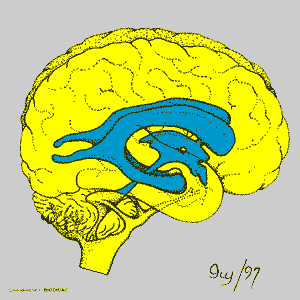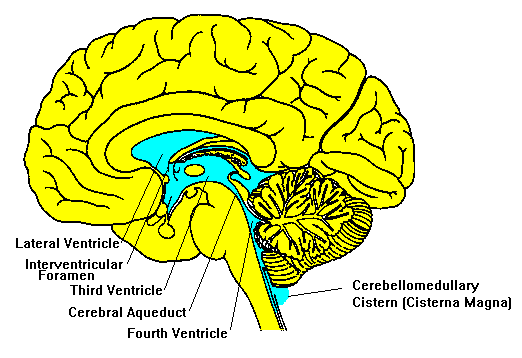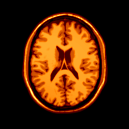 | The
Ventricular System
and CSF (Cerebrospinal Fluid) |
 |
| The entire surface of central nervous system is bathed by a clear, colorless fluid called cerebrospinal fluid (CSF). The CSF is contained within a system of fluid-filled cavities called ventricles. The ventricles are shown in blue on the following midsagittal section of the brain. | ||
Absorption of the CSF into the blood stream takes place in the superior sagittal sinus through structures called arachnoid villi . When the CSF pressure is greater than the venous pressure, CSF will flow into the blood stream. However, the arachnoid villi act as "one way valves"...if the CSF pressure is less than the venous pressure, the arachnoid villi will NOT let blood pass into the ventricular system. |
| Ok..so there is CSF
flowing
through the ventricles...what does the CSF do?
The CSF has several functions including:
|
 Image adapted from Biodidac |
|
Under some pathological conditions, CSF builds up within the ventricles.
This condition is called hydrocephalus.
Hydrocephalus may result from:
|
 Hear It |
"Ventricle" | "Choroid Plexus" | "Arachnoid villi" | "Hydrocephalus" |
For more about CSF and
hydrocephalus,
see:
|

| BACK TO: | Exploring the Nervous System | Table of Contents |
![[email]](./gif/menue.gif) Send E-mail |
 Get Newsletter |
 Search Pages |
 Donate to Neuroscience for Kids |

 CSF is produced mainly by a structure
called the choroid plexus in the lateral,
third and fourth ventricles. CSF flows from the lateral ventricle to the
third ventricle through the interventricular
foramen (also called the foramen of Monro). The third ventricle
and fourth ventricle are connected to each other by the cerebral aqueduct (also called the Aqueduct of Sylvius). CSF
then flows into the subarachnoid space through the foramina of Luschka
(there are two of these) and the foramen of Magendie (only one of
these).
CSF is produced mainly by a structure
called the choroid plexus in the lateral,
third and fourth ventricles. CSF flows from the lateral ventricle to the
third ventricle through the interventricular
foramen (also called the foramen of Monro). The third ventricle
and fourth ventricle are connected to each other by the cerebral aqueduct (also called the Aqueduct of Sylvius). CSF
then flows into the subarachnoid space through the foramina of Luschka
(there are two of these) and the foramen of Magendie (only one of
these). To model how the CSF works,
To model how the CSF works,  Some CSF facts:
Some CSF facts: